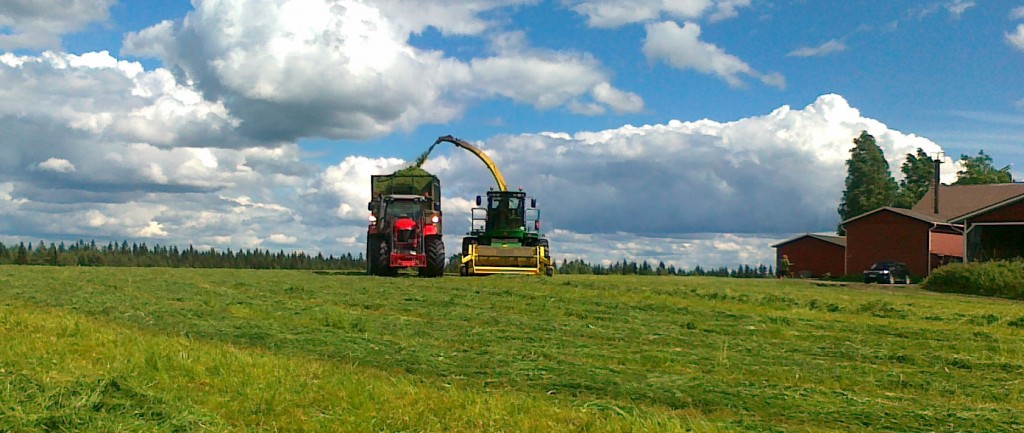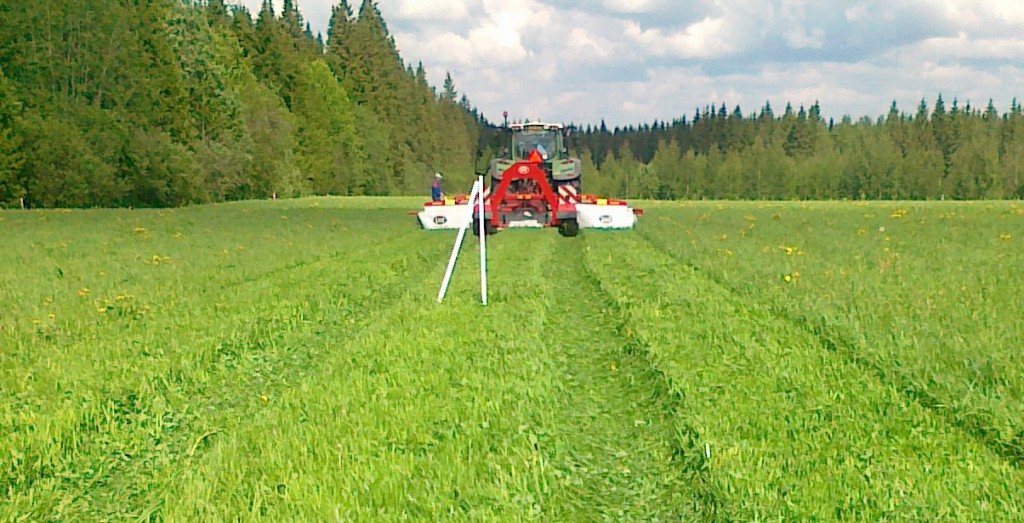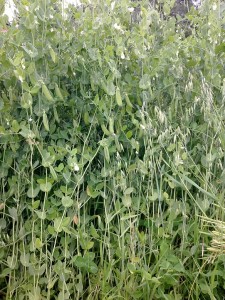
On-farm research is a new and efficient tool, which may be helpful to assess good cultivation practices with farmers. As part of SOLID WP1, a number of successful trials were carried out in Finland – demonstrating the advantages of participatory research for both farmers and researchers.
By Päivi Kurki and Arja Nykänen, WP1
On-farm research is an attractive method for farmers to test suitable farming practices in their own environment. In cooperation with advisors and scientists, the topics are formulated taking wider views and theoretical background into account.
As part of SOLID WP1, on-farm research actions took place in Finland in 2013 in order to increase the protein self-sufficiency of organic dairy farms. This specific topic rose up in workshops held before the on-farm trials, and was also recognised as being important in other parts of Europe.
The trials covered two topics: on two farms the mixture of red clover and grass was topped and on two farms different mixtures of peas and cereals were tested. All participating farms were organic and located in eastern Finland, and the fields were moraine soils, which are quite warm with good water conditions, provided the structure of the field is not damaged.
Could grass topping increase the clover content?
A mixture of red clover (Trifolium pratense L.) and grasses (Phleum pratense L., Festuca pratensis L.) in the silage is the most common forage on Finnish organic dairy and beef farms, but the protein content of the first cut is often low because of low clover content.
The aim of the first two on-farm trials was to increase the protein content of the first cut of a mixed red clover and grass. The farmers wanted to put an observation to the test whether topping of grasses at an early stage could increase the relative competitiveness of red clover in the mixed ley.

The yield of clover-grass was measured by the farmer using his own machinery and by small plot measures of 0.25 m2 carried out by a researcher. The yields and protein contents were compared between topped and non-topped areas.
Spring 2013 was warmer than average resulting in more vigorous and rapid early growth of red clover than usually. The swards were topped when the height of grass averaged 40 and 47 cm in the first and the second field, respectively. In the same fields, the height of red clover averaged 26 and 30 cm, respectively. Greater differences in height between grass and red clover than we found in 2013 had been observed by the farmers before. The apex height of timothy averaged 8 and 20 cm, respectively.
The idea was to cut timothy apex without damaging the red clover. This was not possible under these circumstances and it was decided to top at the height of 30 cm in both fields. The aim to increase the clover content of the yield by using topping was not met under these circumstances. Some successful experiences were obtained in other parts of Finland. The timing of topping in these trials was probably too late. Farmers might be interested to use this method more for green manure than for silage leys. Nevertheless the work stimulated interest in the farmers to test concepts on their own farms.

Optimal seed mixture for pea and cereals
The aim of the other on-farm trials was to find the most productive pea cereal mixture with a high pea – and consecutively protein – content. Pea cereal mixtures are cultivated to produce on-farm concentrates. They also provide a good break crop in the crop rotation since there is no clover in the mixture.
Five mixtures of peas (Pisum sativum L.) and cereals (spring wheat; Triticum aestivum L. or spring oats; Avena sativa L.) were tested on two organic dairy farms. The seed amounts in the mixtures varied from 150 to 270 kg/ha of pea and from 50 to 150 kg/ha of cereals and the yield and pea content in the yield were recorded. The yields were measured by farmers using a combined harvester equipped with scales.
The optimum seed mixture was 200 kg ha-1 of pea and 100 kg ha-1 of spring wheat. The role of the cereals was to prevent the stand from lodging, but in some cases cereals also shaded the peas and smothered them out.
On-farm trials have a lot to offer
The on-farm experiments were relatively easy to carry out with help of good machinery and there was high interest by the farmers in the topics. The farmers were very keen on the results as the questions came from them and the answers were found on their own fields.
The discussion part before and after the experimental work is the most important phase in the on-farm participatory research. In this case, discussions took place together with farmers, advisors and researchers to define the questions, and to conclude from results and experiences afterwards.
Read more: Homegrown proteins in Finland
The trials showed examples of successful cooperation and networking of farmers, advisors and researchers. The aims to get more information for the farmers themselves and to disseminate it efficiently to other farmers by professional magazines, Internet and open field days were also met.
All in all, on the basis of the experiences from the trials in Finland, on-farm experiments have a lot to offer both farmers and researchers.
AUTHORS


